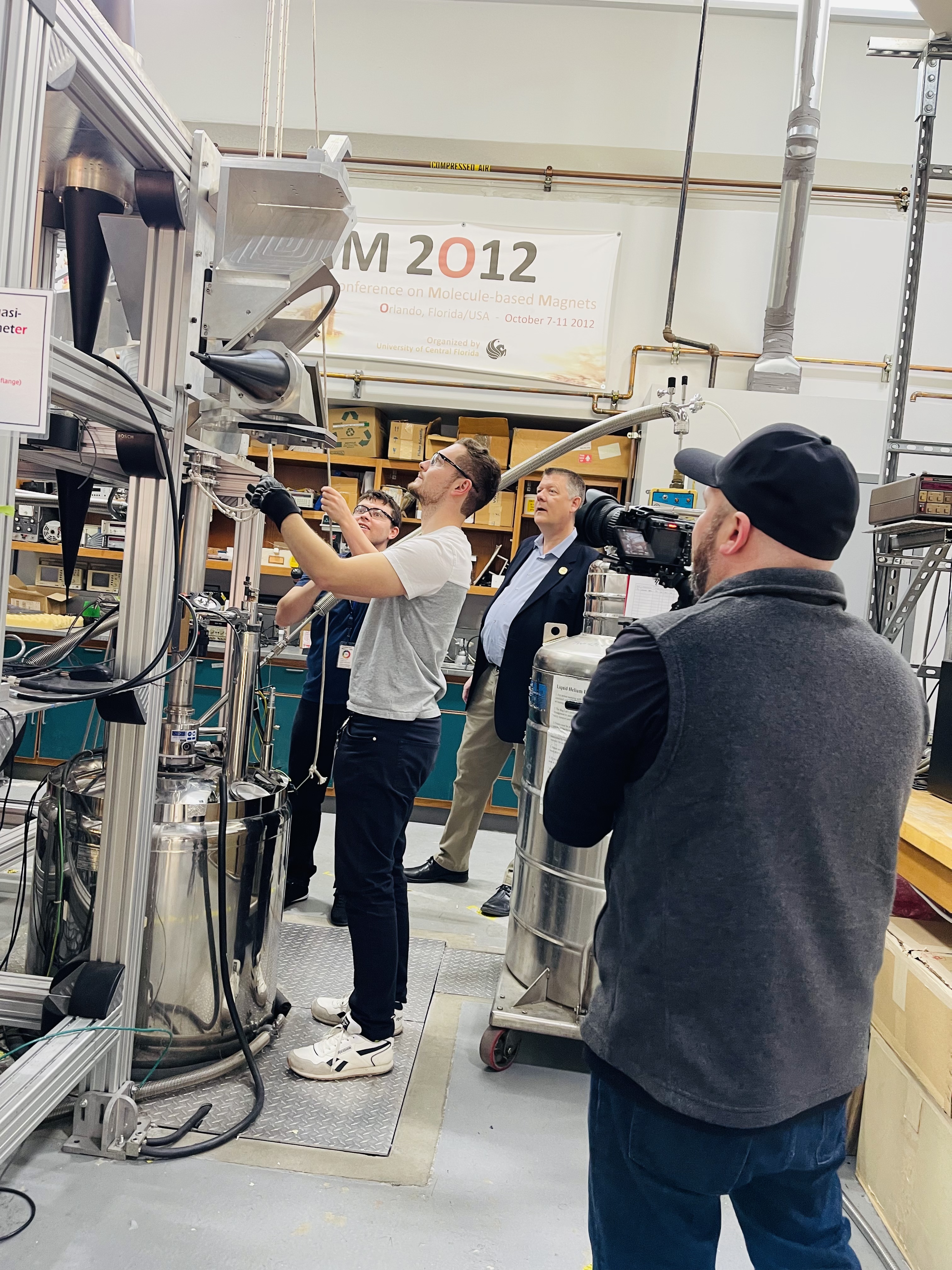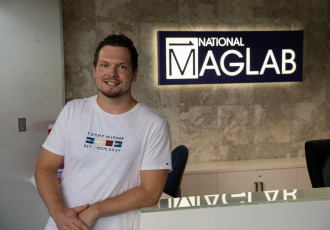Jakub Hrubý studied physical engineering and nanotechnology at the Faculty of Mechanical Engineering, Brno University of Technology, spent his doctoral studies at CEITEC Brno University of Technology, and since 2022 has been working as a postdoc at the National High Magnetic Field Laboratory (NHMFL) at Florida State University (FSU). In America, he is currently working on the development of a unique bolometer and searching for qubits suitable for quantum information transfer. However, we didn’t just talk to Jakub about work. We were also interested in what life “across the pond” is like for a Czech scientist.
Jakub, it is your third year on the American academic soil. Have you encountered any significant differences in the approach to work or study during that time?
I must say that I haven’t noticed any striking differences in approach; I think it’s quite similar here to Europe in general. Perhaps I would say that, unlike in the Czech Republic, the distribution of work on projects differs. Here, people take fewer projects at a time, but they can easily spend four or five years on them and then publish an article with the results of their research in a prestigious journal. In the Czech Republic, it is common for scientists to work on a larger number of projects at once, but they don’t devote as much time to them and publish more quickly in less prestigious journals. On the other hand, it is true for both countries that you should not put all your eggs in one basket in science, because one never knows in advance which project will be successful, and which will not. And I think that this tactic of moving across several different topics is paying off for me here.
In today’s Europe, it is standard to work in informal settings, typically in cafés. Is this also common in America, do people meet over coffee or in a bar to work?
I like America, but I definitely think that when it comes to social customs, it may not be for everyone. For example, here in the south, where I work, it is uncommon for people to sit in a large group for coffee and discuss work or even private matters during the day. And I would say that these customs, are “the lack thereof”, is also reflected in other areas of life. People here have houses, cars, and commute to work. Then they come home and spend their time in private, perhaps with friends. Readers in Czechia will probably be amused when I say that there aren’t really that many sidewalks here because people don’t walk much. Also, it is 95°F during the summer and humid, like in a tropical plant pavilion, so you can’t really walk outside. Summer in Florida is not like summer in Europe; it has a humid subtropical climate half the year. Nor have I encountered the same easy approach to travelling here as in Europe. At home, you can simply decide that you haven’t seen Milan yet, and in a few hours, you can be there, admiring the beauty of Piazza del Duomo. This doesn’t really work here.
While we’re comparing, I wonder if you believe that Czech technical education is competitive in America. Can a graduate from Czechia hold their own and succeed in the US?
In my opinion, yes. I think that Czech University education is sufficient for people to achieve something here. Especially in the field of chemistry and some technical fields. And especially when I compare it with other nations, because the differences across continents are really visible in education and access to scientific work. Some countries have completely different standards of occupational safety and hygiene in laboratories. The US is a huge Babylon in this respect, with people from Europe, Asia, Latin America. Simply from all over the world. And half of success lies in whether a person fits such a world, can find their way around and, to a certain extent, detach themselves from their homeland, blend in with the international community, and get used to American standards.
This brings me to another question: How do you see your studies at CEITEC in retrospect, now that you have experience with research in the US?
CEITEC certainly gave me a lot; I gained a lot of extremely valuable experience and contacts. I worked there at a time when our research group was just being formed, which meant that we were, so to speak, pioneers, because we were still acquiring some of the equipment and other things we needed for our work, and to a certain extent, we were also adapting the equipment directly to our needs. I can compare now, because I am part of a group that has been operating for years, which means that a scientist can come in and start working right away. At CEITEC, it was a little different back then, and I must say that it actually taught me greater independence and a healthy ability to improvise. But let there be no mistake, CEITEC was and, of course, still is a state-of-the-art facility where everything a scientist needs is available under one roof.
The National High Magnetic Field Laboratory, where you work, is the largest and most powerful facility of its kind in the world. What else makes it unique?
Unlike our competitors, we have access to a large and continuous supply of liquid helium, so we can measure at low temperatures, typically around 5 K. Many laboratories measure what we measure, but only at room temperature, which is extremely limiting for them. Helium is important because it allows us to cool the sample so that the electron spins reach their ground state and then observe and measure their transition to the first excited state. At the same time, there are sources of rare earth metals and actinides here such as lanthanum, praseodymium, and lutetium. These are very expensive materials, which are scarce and access to them is quite limited. The project I worked on dealt precisely with lanthanides and actinides for quantum use. This is despite the fact that there are better candidates on which these phenomena can be observed. But these two elements have not yet been thoroughly researched in terms of their magnetic properties. That is why we are focusing on them; we want to learn as much as possible about them. In fact, I am not aware of anyone else systematically researching such elements in Czechia. Here in the US, and especially in our lab, access to these resources and groups that know how to work with them is easier, so I can work with them and base my research on them. To a certain extent, this gives me freedom in what I will focus on in my research. I have more freedom here.
Last year and this year, you published articles dedicated to the field of molecular quantum informatics. How should we imagine this field?
Simply put, we are looking for materials with specific magnetic properties that could be used to perform quantum calculations. In some molecules, electrons behave like tiny magnets (they have spin). These electrons can be in different energy states, between which we can “jump” using microwaves or light – we call this a transition. Usually, the energy difference between these states depends on the magnetic field. If the magnetic field changes, this energy difference also changes – and the transition “shifts”. A “clock transition” is a special case where we find a transition and a magnetic field such that even if the field changes slightly, the energy difference remains almost the same. This makes the transition very stable and protects it against local magnetic noise from surrounding molecules and the environment. It is precisely these transitions that exhibit an extended coherence time T2, i.e., the time during which quantum operations could be performed. Investigating this phenomenon is key to the development of new concepts in quantum information science based on electron spins in molecules prepared by chemists, because the longer the T2 time, the more logical operations can be performed during it. Although the current systems used in quantum physics have a long coherence time, they offer limited scalability and tunability. Therefore, together with our chemist colleagues, we are trying to create a suitable concept of molecules, which we then measure using pulsed electron spin resonance and further study the possibilities and limits of these special transitions.
Could you summarize the main objectives of your research?
In last year’s study, we focused on the praseodymium molecule in the 2+ oxidation state, which provides one electron in its ground state. The transition with extended coherence time is caused by a hyperfine interaction between the electron and the nucleus of the praseodymium atom and occurs near zero magnetic field. In this case, we were able to identify a transition with a frequency of 9.834 GHz, which is measurable on a pulse spectrometer and which leads to a threefold increase in coherence time compared to other transitions in the sample. This in itself is not much of an improvement, but in this case, we were interested in whether such transitions exist at all.
Last year, you also published an interesting article about a graphene bolometer that can detect electromagnetic radiation directly on a chip. What exactly was it about?
First, it is necessary to explain what a bolometer is. Bolometers are sensitive sensors for non-contact measurement of changes in electrical resistance depending on changes in the temperature of the sensor on which electromagnetic radiation falls. It works by radiation falling on the sensitive element of the bolometer and slightly heating it, thereby changing the electrical resistance, which can be converted into radiation intensity. Thanks to their high sensitivity and ability to detect minute amounts of incident radiation, these devices are used, for example, in astrophysics. They are also used in spectroscopy such as electron paramagnetic resonance (EPR) and infrared spectroscopy, as well as microwave/terahertz technologies. In a typical electron paramagnetic resonance setup, microwaves propagate from the source to the sample and back to the detector. By using on-chip detection, we have found a way to reduce transmission losses and thus eliminate the entire detection arm.
How did you achieve this?
Currently commercially available bolometric detectors are often based on III–V semiconductors (e.g., InSb – indium antimonide) and use so-called hot electrons. At low temperatures, the electron gas in the metal is only weakly bound to phonons (vibrations of the crystal lattice). After absorbing electromagnetic radiation, the electrons heat up, become unbalanced with the phonons, and create a high-energy electron gas. A similar phenomenon can be achieved using a graphene bolometer based on hot electrons. However, since pure graphene is not ideal for functional bolometric devices, it first had to be modified. The graphene bolometer was created by epitaxy on SiC, a compound semiconductor with a wide band gap, which, thanks to its properties, is suitable for applications requiring high-temperature and high-voltage operation. Epitaxy is the process of growing a thin layer of crystalline material directly on a substrate. The epitaxial layer has the same crystal structure and orientation as the substrate, which ultimately creates a high-quality interface between the two materials. We then sputtered palladium, which created defects in the graphene structure. In our study, we used a specially shaped graphene bolometer that functions as a quantum dot—a nanostructure in which electrons are trapped. These trapped electrons create an energy barrier that electrons must overcome in order for electric current to flow through the dot. This principle enabled us to detect very sensitively the decrease in microwave radiation intensity caused by the resonant absorption of an unpaired electron. We used such a detector for EPR spectroscopy – it functioned simultaneously as a bolometer and as a substrate for a chip detector with the organic radical DPPH, which is a standard stable radical marker for testing in EPR spectroscopy.
You mentioned that thanks to this design, the bolometer does not need a detection arm, is that right?
Yes, it is. This approach eliminates the need for a spectrometer detection arm, thereby reducing signal loss on the way to the detector. In an EPR spectrometer with high magnetic fields, the detector is usually located several meters away from the sample. Depending on the design of the spectrometer and the operating frequency, losses in the sample-detector path can reach up to 10 dB – a tenfold decrease in power. Therefore, it is advantageous to have the detector directly below the sample. The magnetic field can also affect the operation of the detector, which we also investigated in a graphene bolometer, and the effect on functionality was negligible. External bolometers also need to be cooled to low temperatures, while the bolometer on the chip is cooled together with the sample under study. This significantly reduces measurement costs and eliminates the need for an externally cooled bolometric device.
Has your bolometer already been put into practice? Can scientists work with it?
Not yet. We have created a prototype, which we are still working on. For now, we consider graphene to be the reference standard, and we would like the detector to work with other molecules as well. The study I mentioned proved that the technology works. So our device is not yet on the market, but it looks like we are on the right track.
You are currently based in Florida, but do you have any plans for the future? Would you like to stay in America after your contract at NHMFL ends?
It’s really hard to say at the moment. The situation in the US is very dynamic right now, and it is quite possible that I will decide to return to Europe in some time. But I will stay here for at least another year because my contract is still running. Life in Florida is really different from life in Czechia in many ways. The climate is different, as are public events, food choices, and attitudes toward eating. Of course, the natural environment is different, and as I said at the beginning, interpersonal relationships are different here, too. Nevertheless, I am happy here so far, and I am glad that I can contribute to future progress. So for now, I am open to all possibilities, and I’ll see what happens.
Author: Kristina Blűmelová


 Share
Share

